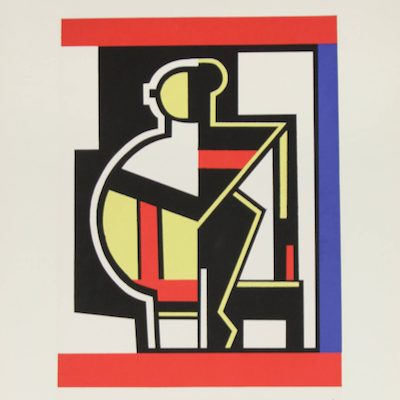
Details
Artist
Styles
Etching and aquatint in colours, on BFK Rives paper, with full margins. - This work is from the UNITÉ book, which began to be printed in 1963 and ended on October 15, 1965 in Paris. - I. 41.5 x 31.5 cm (16 3/8 x 12 3/8 in.) - S. 57 x 45.2 cm (22 1/2 x 17 3/4 in.) - Signed and numbered in pencil, from the edition of 130 pc + 30 in Roman numerals, published by Atelier Crommelynck, Paris // Le Corbusier’s Unité 5 (1963-1965) is a limited-edition etching and aquatint printed on BFK Rives paper, displaying a vibrant array of colors and abstract forms. The composition features a central mechanical-like structure in bold red, black, and brown, while the upper half includes dynamic flying figures in yellow, blue, and red, which evoke a sense of movement and freedom. The combination of organic forms with industrial, mechanical elements highlights Le Corbusier's fascination with the interplay between nature and technology. The textured background of green and gray adds depth, creating contrast and balance between the colorful figures and the structured, grounded forms below.
Unité 5, 1963-1965
form
Medium
Size
57 x 45.2 cm
- Inches
- Centimeters
Edition
Price
- USD
- EUR
- GBP
Details
Artist
Styles
Etching and aquatint in colours, on BFK Rives paper, with full margins. - This work is from the UNITÉ book, which began to be printed in 1963 and ended on October 15, 1965 in Paris. - I. 41.5 x 31.5 cm (16 3/8 x 12 3/8 in.) - S. 57 x 45.2 cm (22 1/2 x 17 3/4 in.) - Signed and numbered in pencil, from the edition of 130 pc + 30 in Roman numerals, published by Atelier Crommelynck, Paris // Le Corbusier’s Unité 5 (1963-1965) is a limited-edition etching and aquatint printed on BFK Rives paper, displaying a vibrant array of colors and abstract forms. The composition features a central mechanical-like structure in bold red, black, and brown, while the upper half includes dynamic flying figures in yellow, blue, and red, which evoke a sense of movement and freedom. The combination of organic forms with industrial, mechanical elements highlights Le Corbusier's fascination with the interplay between nature and technology. The textured background of green and gray adds depth, creating contrast and balance between the colorful figures and the structured, grounded forms below.
- Recently Added
- Price (low-high )
- Price (high-low )
- Year (low-high )
- Year (high-low )
What is Cubism?
Cubism is an art movement that aimed to depict multiple perspectives of objects or figures within a single picture. Artists Georges Braque and Pablo Picasso pioneered this style around 1907. The name Cubism emerged from their use of geometric shapes and outlines that often resembled cubes, breaking objects down into abstracted forms.


























